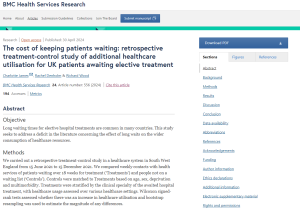Longer hospital wait times are leading to patients accessing more healthcare services
7 May 2024
People who are on a waiting list for hospital treatment are accessing healthcare services more than their peers who aren’t awaiting treatment. This means that long waiting lists for elective (scheduled rather than emergency) care could represent a significant and previously unrecognised hidden cost to the health service, according to the results of a study published in BMC Health Services Research.
The study team looked at how often patients waiting for hospital treatment over the 18-week standard would access healthcare services compared to people not on waiting lists. People not waiting for treatment were matched with those on waiting lists based on age, sex, socioeconomic status, and the presence of other health conditions. Healthcare service use included:
- Primary care (GPs)
- Secondary care (specialist care)
- Helpline calls to the 111 service
- Emergency calls to the 999 service
- Community services
- Mental health services
Researchers found evidence of increased healthcare service use among people waiting for different types of treatment. For example, those waiting for cardiothoracic surgery showed the largest increase in the level of additional care they used. However, at least 50 per cent of patients waiting for oral surgery, or ophthalmology, gynaecology and dermatology services didn’t use healthcare services more than their peers who weren’t on a waiting list for treatment.
The study team also found a difference in the type of healthcare services used by those waiting for treatment. Primary care prescriptions and specialist care were most in demand. Mental health services, emergency calls and helpline calls demonstrated the smallest difference in uptake.
Dr Charlotte James, lead author, said:
“In the UK, we have an 18-week referral-to-treatment target. Before the pandemic, 86 per cent of patients were being seen within this timeframe. However, since March 2020 this has dropped to 62 per cent, while the number of patients on waiting lists has increased by over 50 per cent.
“When looking at NHS services aimed at reducing this backlog of people waiting for treatment, we should look not only at how much it costs to carry out a procedure but also at the additional resources being used by patients waiting longer for treatment.
“The results of our study demonstrate that increased waiting times impact both patients and health services and our findings are relevant for clinicians and managers to better understand patient need and reduce potential harm.”
Paper
